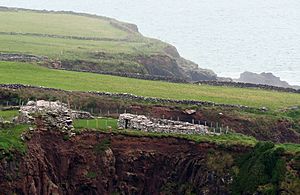Promontory fort facts for kids
Imagine a natural fortress built by ancient people! A promontory fort is a special kind of old fort. It's usually found high up on a cliff, often with steep drops on three sides. This makes it very hard for enemies to attack. The only easy way in is usually a narrow strip of land connecting it to the main area.
Most of these forts were built during the Iron Age, which was a long time ago. You can find many promontory forts in places like Ireland, the Isle of Man, Brittany (in France), and parts of England like Devon and Cornwall.
Contents
Promontory Forts in Ireland
Not many promontory forts in Ireland have been fully studied by archaeologists. Most of them seem to be from the Iron Age. However, some, like Dunbeg Fort in County Kerry, might even be older, possibly from the Bronze Age.
Other forts, such as the one on Dalkey Island in County Dublin, have shown interesting finds. Archaeologists have found pieces of pottery that came all the way from the Eastern Mediterranean! This tells us that these places were used again and changed during the early Middle Ages.
Promontory Forts on the Isle of Man
On the Isle of Man, you'll find many promontory forts, especially on the rocky cliffs in the south. More than 20 of these forts exist, and four of them have been explored by archaeologists.
Many of these forts, especially in a place called Santon, can be visited today. You can reach them by walking along the Raad ny Foillan coastal path. All these forts have a strong wall, called a rampart, on the side that faces the land. This was their weakest point. Digging at a fort called Cronk ny Merriu showed that the entrance was a very strong gate.
Later, around the 700s and 800s AD, the Vikings came to the Isle of Man. Sometimes, they would reuse these old Iron Age promontory forts for their own purposes.
Promontory Forts in Devon and Cornwall

You can find many promontory forts all along the coast of Penwith in Cornwall. One of the oldest is Maen Castle, which is near Land's End. It was built around 500 BC.
Other famous promontory forts in Cornwall include The Rumps near Padstow and Dodman Point on the southern coast. There's also Rame Head close to Plymouth. In Devon, you can find them at Burgh Island and Bolt Tail on the south coast. On the north coast, there are Embury Beacon and Hillsborough.
The famous site at Tintagel might be a special example. It's thought to be a promontory fort that was used even after the Romans left Britain, and its use continued into later periods.
Promontory Forts in Brittany
The Roman leader Julius Caesar wrote about the Veneti people in his book de Bello Gallico. The Veneti lived in southern Armorica (which is now Brittany, France). They were powerful sailors and were friends with the people of southern Britain during a war around 56 BC. Caesar described them as living in strong towns, called oppida, on clifftops.
Their main city was Darioritum, located on the Morbihan bay. Today, this city is known as Vannes. The Veneti people spoke Breton, which was similar to the Cornish language. They had strong trade connections with Cornwall and Devon. When the Romans attacked them in Brittany, Julius Caesar reported that Cornwall sent them military help.
Images for kids
-
Entrance to Dunbeg Fort




